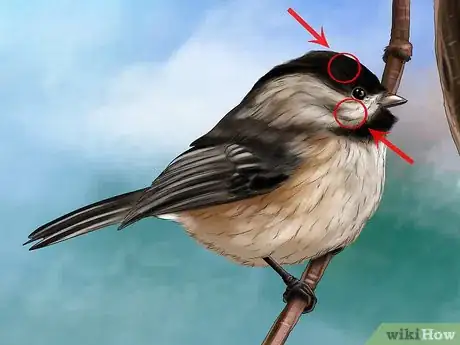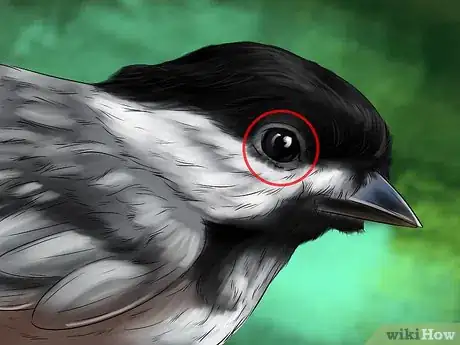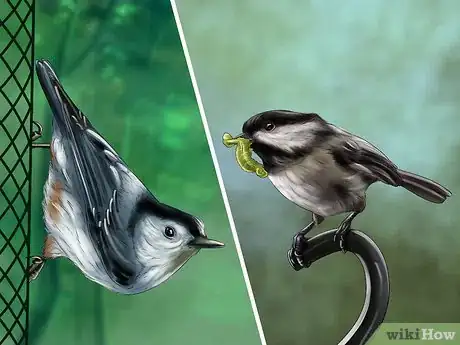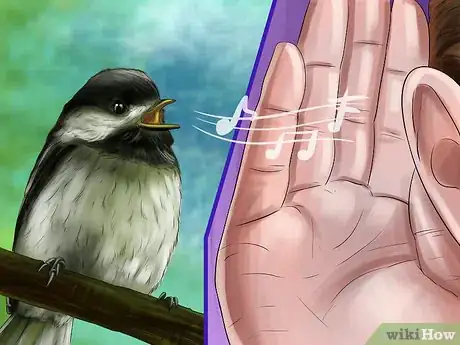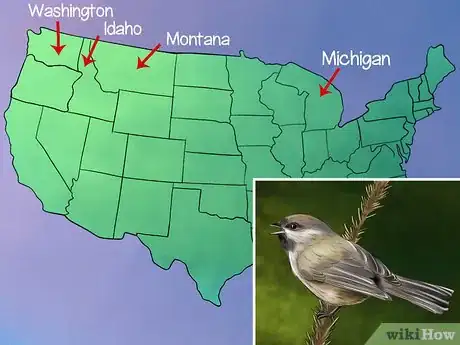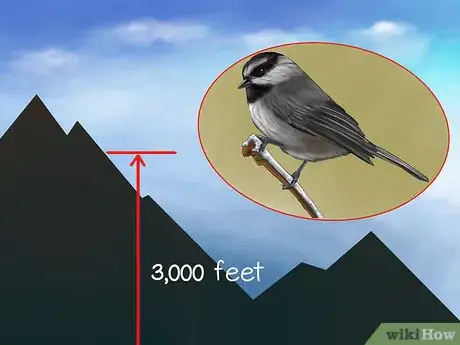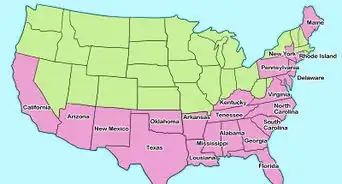This article was co-authored by Roger J. Lederer, PhD. Dr. Roger Lederer is an Ornithologist and the founder of Ornithology.com, an informative website about wild birds. Dr. Lederer has spent over 40 years teaching, studying, and writing about birds. He has traveled to over 100 countries to study birds. Dr. Lederer is an Emeritus Professor of Biological Sciences at California State University, Chico, and has been a Department Chair of Biological Sciences and Dean of the College of Natural Sciences. He has written more than 30 research papers and 10 books on birds and a textbook entitled “Ecology and Field Biology.” Dr. Lederer has consulted the BBC, National Geographic, National Public Radio, ABC News, the Guinness Book of World Records, and numerous other organizations and publications.
wikiHow marks an article as reader-approved once it receives enough positive feedback. In this case, 89% of readers who voted found the article helpful, earning it our reader-approved status.
This article has been viewed 49,215 times.
If you are just starting out birdwatching, it can be helpful to know a few things about the birds you are looking for. A chickadee is a common type of bird found in many parts of the United States and Canada. It is fairly easy to identify a chickadee. However, if you're looking to figure out the specific species of chickadees, you will have to look a little closer.
Steps
Looking at the Bird's Appearance
-
1Look at the bird's size and shape. The chickadee is a very small bird. Larger birds are unlikely to be chickadees. It also has a specific body type to look for.[1]
- The chickadee has a sphere-like appearance due to its short neck and large head.
- A chickadee also has a short, thick bill and a long and narrow tail.
-
2Take in the general color pattern. In general, chickadees will have black heads, or caps, with white cheeks.[2] The back feathers will be some shade of gray. The wing feathers will also be gray, but with white edges.[3]Advertisement
-
3Notice the eyes. A chickadee's cap descends well below its eyes. It can be very difficult to see a chickadee's eyes, as they are often very small and obscured by the cap. If you can easily see an animal's eyes, it may not be a chickadee.[4]
Observing the Bird's Behavior
-
1Watch for foraging. Chickadees often forage for food. If you catch a bird foraging, it may be a chickadee. Chickadees often hop between twigs and grab food off the ground. They also may hang upside down on branches to grab food.[5]
-
2Listen to the songs. Chickadees sing, like most birds. There are a variety of songs chickadees sing.[6]
-
3Watch your bird feeders. Chickadees are very social birds. They're likely to gather around bird feeders. If you see a bird near a feeder, it's likely it could be a chickadee. Watch for other signs of a chickadee, such as its appearance, to confirm.[7]
Identifying Specific Species of Chickadees
-
1Identify the boreal chickadee. The boreal chickadee is generally found in very northern parts of the United States and Canada. If you don't live in very northern Michigan, Washington, Idaho, or Montana, you're unlikely to see this chickadee in the United States.[8]
- The boreal chickadee has a dark pinkish brown cap that fades to gray. The cheeks are white and then also fade to gray behind the eye.
- The underparts of the bird are generally olive gray, while flight and tail feathers are dark gray. Tail feathers have white fringes.
-
2Recognize the chestnut-backed chickadee. Chestnut-backed chickadees are generally found in the Pacific Northwest. They have a white face and a dark brown crown. The underparts of the bird are dotted in a chestnut color, hence the name.[9]
- The chestnut on the underparts of the bird are noticeable because they contrast greatly with the dark gray tail and flight feathers.
- The flanks of the bird are a chestnut color, contrasting with the white belly.
-
3Look for the mountain chickadee. Mountain chickadees are generally found in the mountains or places with high elevations. They're unlikely to be found anywhere with an elevation below 3,000 feet (910 m).[10]
- The mountain chickadee has a sooty black cap and also sooty black patches around the eyes.
- Underparts of the bird are grayish brown. The flight and tail feathers are a slightly darker gray.
-
4Identify the Carolina chickadee. The Carolina chickadee exists mostly in the Southern parts of the United States, usually in the woods or along the edges of streams. It has a sooty black cap, that extends towards the lower back, as well as white cheeks.[11]
- The bird also has a black bib.
- The upper parts of the bird are olive gray with darker tail feathers.
-
5Recognize the black-capped chickadee. The black-capped chickadee is the most common type, found in most part of the United States outside of the south. They are found in a great number of habitats.[12]
- The bird has, as the name implies, a sooty black cap that extends down the back.
- The underparts of the bird are olive gray.
- The tail feathers are slightly darker with fringes of white on the edges.
Expert Q&A
-
QuestionHow do you identify a chickadee by sound?
 Roger J. Lederer, PhDDr. Roger Lederer is an Ornithologist and the founder of Ornithology.com, an informative website about wild birds. Dr. Lederer has spent over 40 years teaching, studying, and writing about birds. He has traveled to over 100 countries to study birds. Dr. Lederer is an Emeritus Professor of Biological Sciences at California State University, Chico, and has been a Department Chair of Biological Sciences and Dean of the College of Natural Sciences. He has written more than 30 research papers and 10 books on birds and a textbook entitled “Ecology and Field Biology.” Dr. Lederer has consulted the BBC, National Geographic, National Public Radio, ABC News, the Guinness Book of World Records, and numerous other organizations and publications.
Roger J. Lederer, PhDDr. Roger Lederer is an Ornithologist and the founder of Ornithology.com, an informative website about wild birds. Dr. Lederer has spent over 40 years teaching, studying, and writing about birds. He has traveled to over 100 countries to study birds. Dr. Lederer is an Emeritus Professor of Biological Sciences at California State University, Chico, and has been a Department Chair of Biological Sciences and Dean of the College of Natural Sciences. He has written more than 30 research papers and 10 books on birds and a textbook entitled “Ecology and Field Biology.” Dr. Lederer has consulted the BBC, National Geographic, National Public Radio, ABC News, the Guinness Book of World Records, and numerous other organizations and publications.
Ornithologist Chickadees often sing "chick-a-dee-dee-dee" in a low, slow voice. They may also whistle a two-noted "fee-bee" or three-noted "fee-bee-ee."
Chickadees often sing "chick-a-dee-dee-dee" in a low, slow voice. They may also whistle a two-noted "fee-bee" or three-noted "fee-bee-ee."
References
- ↑ https://www.allaboutbirds.org/guide/Black-capped_Chickadee/id
- ↑ Roger J. Lederer, PhD. Ornithologist. Expert Interview. 29 April 2021.
- ↑ https://www.allaboutbirds.org/guide/Black-capped_Chickadee/id
- ↑ https://www.allaboutbirds.org/guide/Black-capped_Chickadee/id
- ↑ http://www.audubon.org/field-guide/bird/black-capped-chickadee
- ↑ http://animals.nationalgeographic.com/animals/birding/black-capped-chickadee/
- ↑ http://www.audubon.org/field-guide/bird/black-capped-chickadee
- ↑ http://www.birdsource.org/Birds/chickadees/
- ↑ http://www.birdsource.org/Birds/chickadees/
About This Article
To recognize a chickadee, look for a small, round body, with a short neck, large head, and short, thick bill. Additionally, check its coloring, since chickadees typically have black heads, white cheeks, and gray bodies with some white on the edges of their wings. You can also identify a chickadee by its very small eyes that can be hard to see in its black head. If you're close enough to it, try listening for its song, which sounds like “chick-a-dee-dee-dee.” For more information from our Veterinary co-author, including how to identify different species of chickadees, read on!

